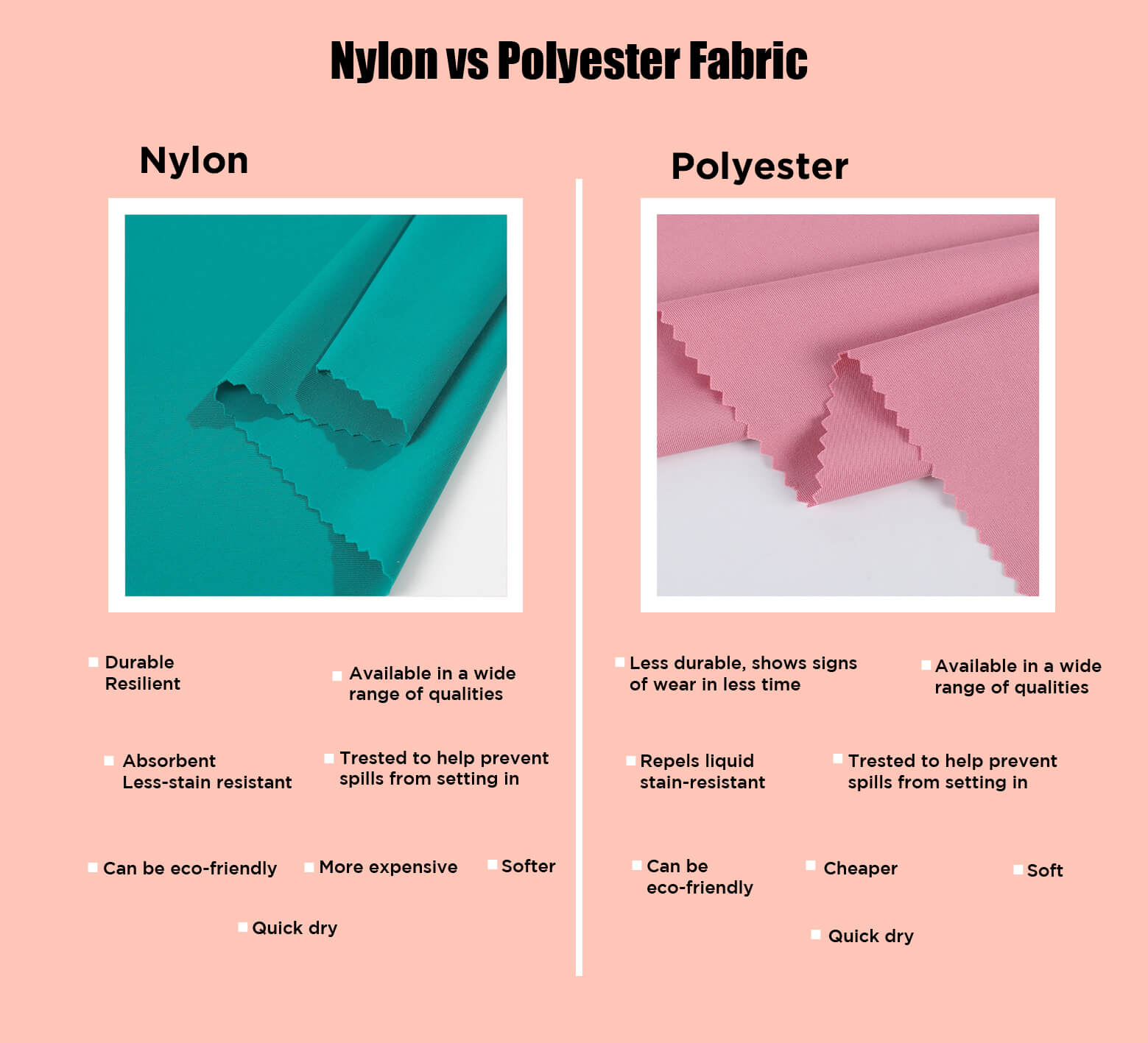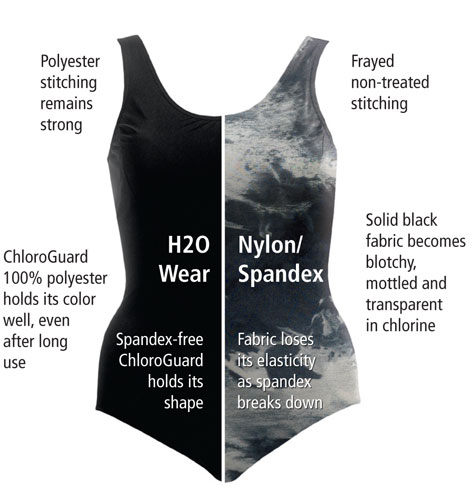Nylon and spandex are two synthetic fabrics commonly used in clothing. Nylon is a strong, durable material that is resistant to abrasion and tearing, while spandex is a stretchy material that can stretch up to 600% of its original length.
Combining these two materials can create a fabric that is both strong and flexible, making it ideal for use in sportswear and athletic clothing. Nylon is also often used in hosiery and lingerie due to its smooth and silky texture, while spandex is used in tight-fitting garments such as leggings and bodysuits.
Overall, both nylon and spandex have unique qualities that make them useful in a variety of clothing applications.

Credit: www.lezhougarment.com
Table of Contents
Nylon Vs Spandex: A Fabric Showdown
Nylon and spandex are two popular synthetic fabrics that have revolutionized the textile industry. It was the first synthetic fabric developed, introduced by DuPont in 1938, while spandex, also known as Lycra, made its debut in the 1950s. Nylon is known for its exceptional strength, durability, and abrasion resistance, making it ideal for products like stockings, parachutes, and ropes. On the other hand, spandex is celebrated for its remarkable elasticity, providing unparalleled stretch and recovery, which is why it’s commonly used in sportswear, swimwear, and form-fitting garments. Both fabrics offer unique properties that cater to different needs, with nylon excelling in strength and spandex dominating in stretchability.
| Nylon | Spandex |
|---|---|
| Durable | Elastic |
| Abrasion-resistant | Stretchable |
| Used in stockings, parachutes | Commonly used in sportswear, swimwear |

Credit: m.youtube.com
The Chemistry Behind The Stretch
The chemistry behind the stretch in nylon involves polyamide molecules, which are formed through a condensation reaction between diamines and diacids. This results in a strong and resilient polymer that can be spun into fibers. On the other hand, spandex is composed of polyurethane chains that are capable of significant elongation. The unique structure of spandex allows it to stretch up to 600% of its original length, making it a popular choice for clothing that requires a high degree of elasticity. Both materials offer exceptional stretch and recovery properties, but their chemical compositions and manufacturing processes contribute to their distinct characteristics and applications.
Durability And Resistance
Nylon and spandex both offer durability and resistance, but in different ways. Nylon is known for its strength and abrasion resistance, making it ideal for tough, long-lasting products. On the other hand, spandex provides exceptional elasticity and resistance to stretching, ensuring flexibility and shape retention in various applications.
| Nylon Vs Spandex | |
|---|---|
| Durability and Resistance | |
| Nylon’s Abrasion Resilience | Spandex’s Elasticity |
| Nylon is known for its impressive abrasion resistance, making it highly durable and long-lasting. It can withstand friction and wear, making it ideal for products that require strength and resilience. Whether it’s used in clothing, upholstery, or industrial applications, nylon’s ability to resist damage from rubbing, stretching, and bending is unparalleled. | On the other hand, spandex is renowned for its exceptional elasticity. Its ability to stretch and recover is unparalleled, making it a popular choice in clothing that requires flexibility and a snug fit. From sportswear to swimwear, spandex’s elasticity allows for comfortable movement and a flattering appearance. |
Comfort And Fit
When comparing Nylon and Spandex, one important factor to consider is comfort and fit. Both materials offer stretch and flexibility, allowing for a snug yet comfortable fit. Nylon is known for its breathability, allowing air to circulate and keeping the body cool. On the other hand, Spandex excels in moisture management, wicking away sweat and keeping the skin dry. This makes Spandex a popular choice for activewear and athletic apparel.
Another advantage of both Nylon and Spandex is their ability to adapt to body movements. They provide excellent elasticity, allowing for unrestricted motion and ensuring a comfortable experience during physical activities. Whether it’s bending, stretching, or jumping, Nylon and Spandex fabrics move with the body, providing support and enhancing performance.
| Comfort and Fit | Breathability and Moisture Management | Adapting to Body Movements |
|---|---|---|
| Nylon and Spandex offer a comfortable and snug fit. | Nylon is breathable, while Spandex excels in moisture management. | Both materials adapt to body movements, providing flexibility and support. |
Care And Maintenance
Care and maintenance of nylon and spandex fabrics is essential for their longevity. Regular washing in cold water and gentle detergent is recommended, along with avoiding excessive heat during drying. Additionally, storing these fabrics away from direct sunlight can help prevent fading and damage.
| Washing and Drying Techniques | Longevity of Fabric Life |
|---|---|
| Hand washing is the best method for cleaning both nylon and spandex fabrics. Use a mild detergent and cool water to gently wash the garment. Avoid using hot water or bleach as it can damage the fabric. After washing, gently squeeze out the excess water and lay the garment flat on a towel to air dry. If machine washing is necessary, use the delicate cycle and place the garment in a mesh laundry bag. Hang or lay flat to dry. | Proper care and maintenance can extend the life of both nylon and spandex fabrics. Avoid exposing the garment to direct sunlight or heat as it can cause the colors to fade and the fabric to weaken. Never iron or dry clean nylon or spandex fabrics as it can damage the material. Instead, store the garment in a cool, dry place away from any potential sources of damage. |
Environmental Impact
Nylon and spandex both have environmental impacts. Nylon production releases greenhouse gases, while spandex is made from non-renewable resources. Both materials contribute to microplastic pollution in oceans. Consider eco-friendly alternatives like organic cotton or recycled polyester for sustainable fashion choices.
| Environmental Impact: |
| Production Footprints |
| Nylon and spandex both have a significant environmental impact during production. The production of nylon requires a lot of energy, water, and chemicals, contributing to greenhouse gas emissions and water pollution. On the other hand, the production of spandex requires less energy and water but still uses chemicals that can harm the environment. |
| Recycling and Sustainability Efforts |
| When it comes to sustainability and recycling efforts, both nylon and spandex have room for improvement. Nylon is recyclable, but the process is not widely available or economically feasible. However, some companies have started to use recycled nylon in their products. Similarly, spandex is not widely recycled, but some companies are experimenting with more sustainable alternatives like plant-based elastane. |
Popular Uses In Fashion And Sportswear
Nylon and spandex are two widely used materials in the fashion and sportswear industry. Both materials offer unique properties and benefits that make them popular choices for various applications.
In athletic apparel, the trend has been shifting towards using more spandex due to its exceptional stretch and recovery capabilities. Spandex allows for greater flexibility and freedom of movement, making it ideal for activewear such as leggings, sports bras, and compression garments.
On the other hand, nylon is often favored for its durability and moisture-wicking properties. It is commonly used in sportswear like jackets, shorts, and swimwear, where breathability and quick-drying are essential.
In the world of fashion, nylon and spandex find their place in both everyday wear and high fashion garments. Nylon stockings and tights provide a sleek and polished look, while spandex is incorporated into form-fitting dresses and bodycon designs, accentuating the wearer’s curves.
| Trend | Description |
|---|---|
| Seamless Construction | Eliminates chafing and enhances comfort during workouts. |
| Color Blocking | Combines different colored panels to create visually dynamic activewear. |
| Mesh Inserts | Provides ventilation and adds a stylish element to sportswear. |
In conclusion, nylon and spandex have their distinct uses and are prominent materials in both fashion and sportswear. Understanding their properties and staying updated with the latest trends can help you make informed choices when it comes to selecting the right fabric for your desired application.
The Future Of Fabric Technology
Nylon and spandex are two popular synthetic fibers that have revolutionized the textile industry. These innovative materials have opened up new possibilities in terms of comfort, performance, and style. Nylon, known for its strength and durability, is commonly used in activewear, swimwear, and hosiery. On the other hand, spandex, with its exceptional elasticity, is the go-to choice for form-fitting garments and stretchy fabrics.
Innovations in synthetic fibers have led to the development of smart textiles and wearable technology. Smart textiles incorporate electronic components, such as sensors and conductive fibers, into the fabric itself. These textiles can monitor vital signs, track movement, and even provide therapeutic benefits. Wearable technology, like fitness trackers and smartwatches, has become increasingly popular, and advancements in synthetic fibers have made these devices more comfortable and flexible.
The future of fabric technology looks promising, with ongoing research and development focused on enhancing the properties of nylon and spandex. Innovations in these synthetic fibers will continue to shape the fashion and performance industries, offering endless possibilities for designers and consumers alike.
Making The Right Choice For Your Needs
Choosing the right fabric for your needs can be a tricky decision. Nylon and spandex are two popular options for clothing and activewear. While nylon is durable and lightweight, spandex offers stretch and flexibility. It’s important to consider your specific needs when deciding which fabric is best for you.
| Nylon | Spandex |
| Nylon is durable and abrasion-resistant. | Spandex provides excellent stretch and recovery. |
| It’s breathable and moisture-wicking. | It offers exceptional elasticity. |
| Commonly used in athletic wear. | Great for activewear and swimwear. |
| Perfect for outdoor activities. | Ideal for form-fitting garments. |

Credit: startmakingwaves.com
Frequently Asked Questions
Why Is Nylon Not Recommended For Most Clothes?
Nylon is not recommended for most clothes because it is not breathable, traps sweat and odors, and can cause skin irritations. Additionally, it is prone to static cling, wrinkles easily, and is not eco-friendly.
What Are The Disadvantages Of Spandex?
Spandex can cause skin irritation and lacks breathability, leading to discomfort. It may also lose shape over time.
Is Nylon Or Spandex Better For Shapewear?
Nylon and spandex are both popular choices for shapewear. Nylon offers durability and breathability, while spandex provides excellent stretch and shaping. Ultimately, the better option depends on personal preference and desired level of compression.
What Do Nylon And Spandex Feel Like?
Nylon feels smooth and lightweight, while spandex is stretchy and form-fitting. Both provide flexibility and comfort.
Conclusion
Both nylon and spandex have unique qualities that make them popular in the textile industry. Understanding their differences and applications can help you make informed choices for your clothing needs. Ultimately, the choice between nylon and spandex depends on the specific requirements of the garment and the desired comfort and performance.
